Shri Mariammen temple celebrates 135 years of faith
Then & Now
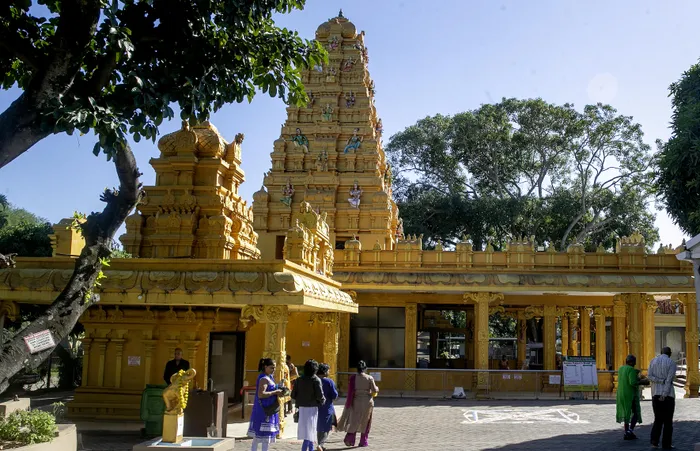
The Shri Mariammen Temple in Mount Edgecombe celebrates its 135th anniversary this year.
Image: Leon Lestrade
EVERY Easter, tens of thousands of devotees from across South Africa gather at the Shri Mariammen Temple in Mount Edgecombe.
Though Easter is not a traditional Hindu holiday, this annual pilgrimage has deep historical roots. It started at a time when indentured Indian labourers (girmitiyas) were only granted leave once a year, at Easter. Seelan Achary the chairperson of the Shri Mariammen Temple says what began as a practical necessity has evolved into a powerful spiritual tradition that has endured for 135 years.
“That was the only time the sugar mill bosses gave our parents time off for the long weekend,” he says. “They were gone from Friday to Monday.”
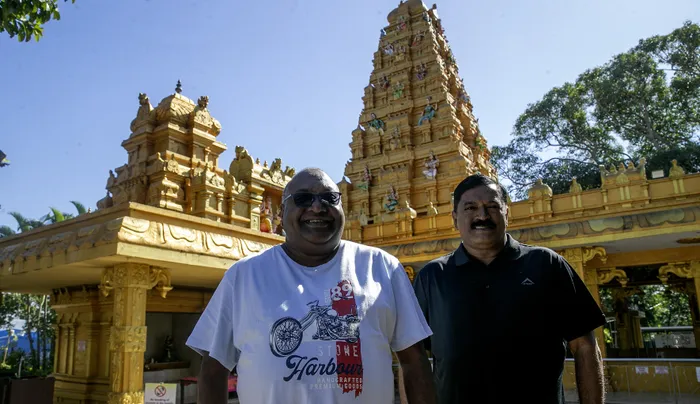
Sydney Govender (left) is the treasurer and Seelan Achary the chairperson of the Shri Mariammen Temple.
Image: Leon Lestrade
Now known as the Mount Edgcombe Easter Festival, it is still the biggest gathering of Hindus in the country. Every year devotees line up in their colourful, traditional garb and wait for up to six hours for their turn to pray. The temple takes care of them and thousands of meals are served.
“We easily get 100 000 people. If you want proof, ask (former presidents) Jacob Zuma, ask Thabo Mbeki. President (Cyril) Ramaphosa came here when he was still Deputy President,” says Achary. To facilitate the thousands of pilgrims, they’ve now started the festivities a day before Good Friday so that the queues move faster.
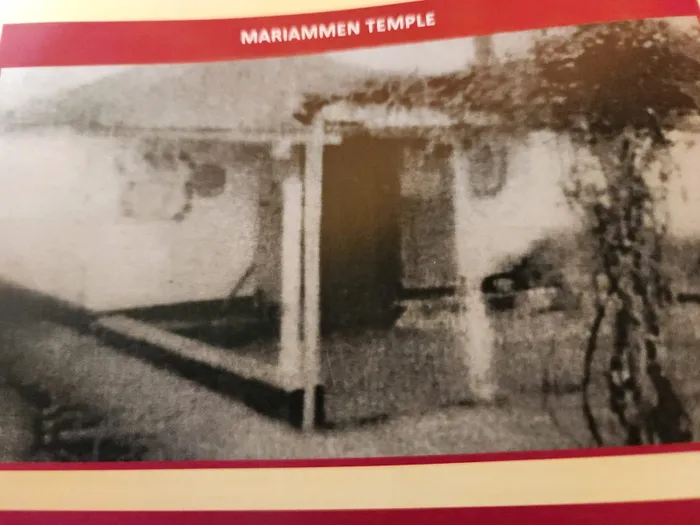
One of the earlier versions of the Shri Mariammen Temple.
Image: Leon Lestrade
It has also evolved into a community event where people from other religions like Christianity and Islam join in, and even participate in the temple’s cultural and music programmes. “Ours is also one of the very few temples where all linguistic groups in the Hindu fraternity are welcome. And we are proud to tell you it works like magic. You come here to pray, you don't come here to ask me what language I'm speaking. So you have Tamil, Telugu, Hindi, Gujarati, all praying, all standing in the same queue,” says Achary.
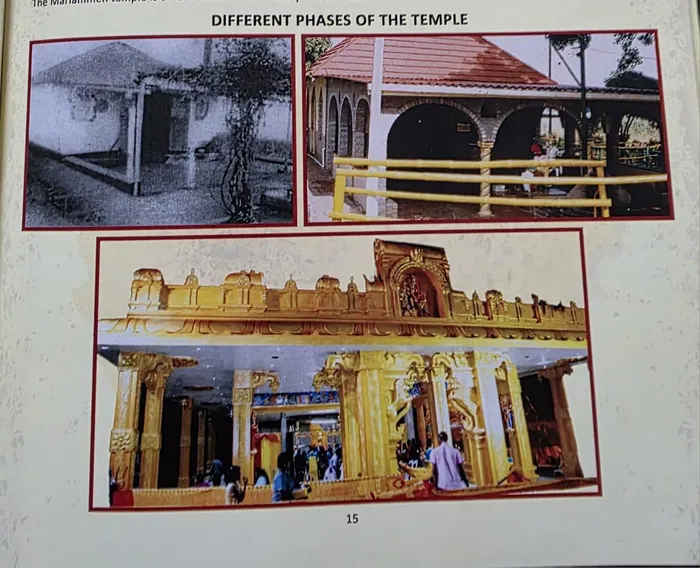
Different versions of the Shri Marieammen Temple which has been built and rebuilt over the years.
Image: Supplied
However, the Shri Mariammen temple is more than just a “pilgrimage” site for Hindus, it’s a vibrant symbol of faith, endurance, and cultural identity. Built in 1890, although unofficially long before that, it carried the hopes and dreams of those who were shipped into the country to work in the sugar plantations. Far from kith and kin and with little but their memories and language to tide them over, the temple became a symbol of hope, healing and resilience.
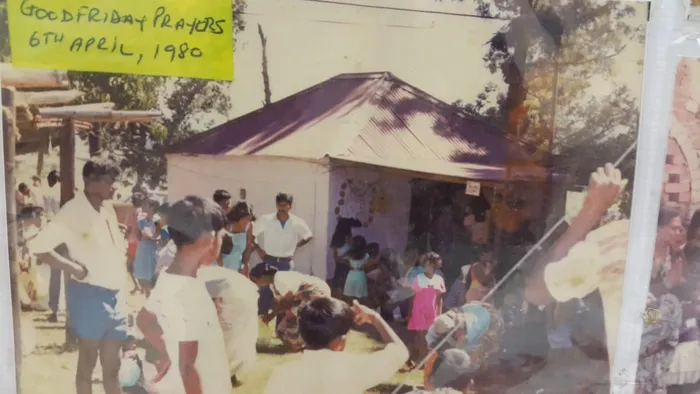
Celebrating the Good Friday prayers at the Shri Marieammen Temple in April 1980.
Image: Supplied
Shri Mariammen, the goddess to whom the temple is dedicated, is revered as a powerful mother figure, a protector from disease, and a giver of rain, fertility, and healing. Many women who struggle to conceive visit the temple to seek her blessings, which Achary and his family also experienced. “So when we couldn't have children, we prayed to the mother for a year or two or three, until we got a daughter. And there are people who have come here to our temple and have testified that they owe their family to the grace of the mother.”
In south India the goddess is known as both fierce and compassionate. It is therefore fitting that a female devotee discovered the sacred site on which the temple stands today. While toiling in the sugarcane fields in the 1800s, a Tamil indentured labourer believed to be named Velatchee, came across a sacred earthen mound (anthill) known as a puthu. Recognising its spiritual significance, she wrapped a sari around it and began to worship there.

Constructing the roof of an earlier version of the Shri Marieammen temple.
Image: Supplied
This act of devotion quickly became a gathering point for Hindus in the area and laid the foundation for what would become one of South Africa’s most significant spiritual landmarks. Today 135 years later, it is a symbol of enduring faith, community and social cohesion.
In 2025 the temple also marked the 25th anniversary of its annual Ammen Awards which recognises local community members from all faiths and cultures for their contribution to sport, education, arts and culture, socio-economic upliftment and promoting Hinduism. This year’s recipients included Kutlwano Christian-Tripp Moloi for community socio-economic upliftment and Ibrahim Sharif for sport. Given its many roles the temple is fondly referred to as “the people’s temple”, according to Achary.
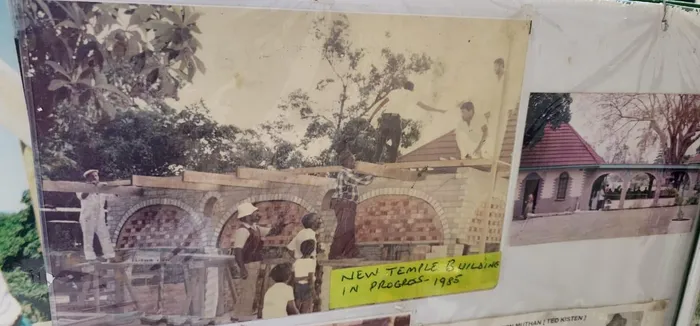
One of the more recent versions of the Shri Marieammen Temple in 1985.
Image: Supplied
Since its humble beginnings the temple has been built and rebuilt with various materials but it is now in its final incarnation which Achary is confident will stand the test of time for generations to come. The temple boasts traditional south Indian architecture and while the building was constructed by locals, specialist artisans were brought in from India to construct the dome. Achary says there are currently seven prayer altars dedicated to various deities on the temple precinct.
“This temple was built by our parents, starting with bamboo and so on. As we started to work and to get money, we built a brick-and-mortar building. We are now in the seventh stage of what you see today.”
Every day at least 100 people make their way to the sacred site, over a weekend it can be up to 2 000 people, he says.
Sydney Govender is the treasurer of the Mount Edgecombe Temple Trust. He says the upkeep of the temple and running costs are hefty. “We need at least R100 000 a month to keep us going. There are bills to pay and workers to pay. Some months we don't know where the money will come from but it always arrives," he says. Both Govender and Achary are confident that the temple will remain in its current form for the next 135 years and continue to serve as an anchor and compass for the next generations.
Related Topics: